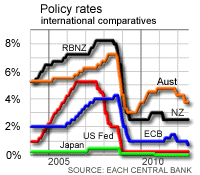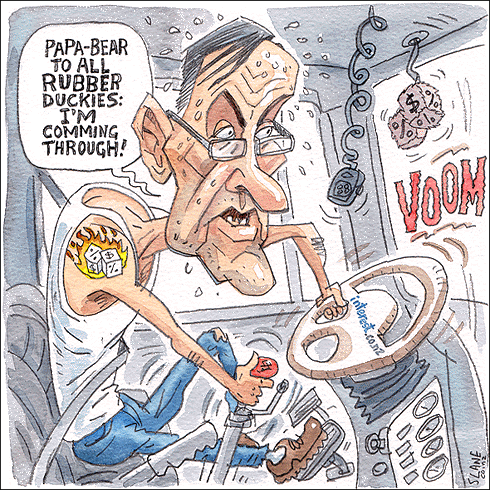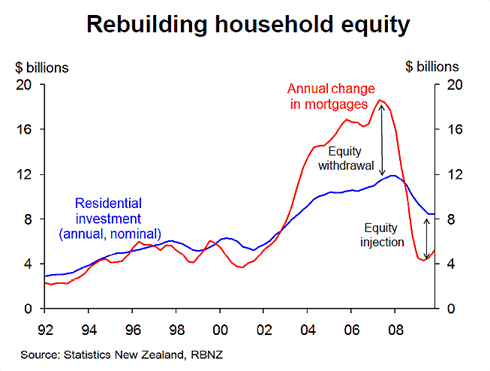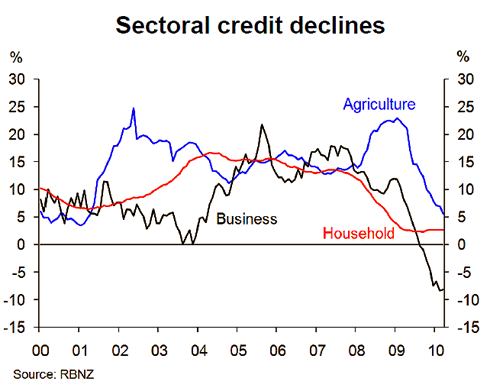 By Bernard Hickey
Reserve Bank of New Zealand Governor Alan Bollard has argued in a speech that New Zealand's economic recovery is now in a new, less fragile phase and it was time to remove the 'very stimulative' setting of the Official Cash Rate being at 2.5%.
(Updates with more details, quotes, chart, link to full speech, currency jump, jobless drop, my view, JP Morgan Chase economist Helen Kevans' view, details and chart on household saving, details and chart on lending growth, Chris Slane cartoon)
Bollard told a Local Government of New Zealand Conference in Dunedin that he was comfortable with financial market expectations of a mid-year rise in the Official Cash Rate and small increases after that for some time.
“Using a truck driver analogy, our foot is strongly on the accelerator. Over coming months we expect to reduce the pressure on this pedal, but in effect to keep some throttle going," Bollard said in the speech.
"Truck drivers know they must reduce acceleration long before the corner. We are not talking about tightening policy yet. We do not expect to have to touch the brake pedal for the some time," he said.
Bollard said it was time for conventional monetary policy to play its part. The New Zealand dollar jumped to 72.7 USc from 71.6 USc in morning trade as traders viewed it as increasingly hawkish and confirmed a likely interest rate increase on June 10 with the next Monetary Policy statements. The 90 day bill rate futures indicated higher interest rates. News of lower-than-expected unemployment at 6.0% also boosted the currency.
By Bernard Hickey
Reserve Bank of New Zealand Governor Alan Bollard has argued in a speech that New Zealand's economic recovery is now in a new, less fragile phase and it was time to remove the 'very stimulative' setting of the Official Cash Rate being at 2.5%.
(Updates with more details, quotes, chart, link to full speech, currency jump, jobless drop, my view, JP Morgan Chase economist Helen Kevans' view, details and chart on household saving, details and chart on lending growth, Chris Slane cartoon)
Bollard told a Local Government of New Zealand Conference in Dunedin that he was comfortable with financial market expectations of a mid-year rise in the Official Cash Rate and small increases after that for some time.
“Using a truck driver analogy, our foot is strongly on the accelerator. Over coming months we expect to reduce the pressure on this pedal, but in effect to keep some throttle going," Bollard said in the speech.
"Truck drivers know they must reduce acceleration long before the corner. We are not talking about tightening policy yet. We do not expect to have to touch the brake pedal for the some time," he said.
Bollard said it was time for conventional monetary policy to play its part. The New Zealand dollar jumped to 72.7 USc from 71.6 USc in morning trade as traders viewed it as increasingly hawkish and confirmed a likely interest rate increase on June 10 with the next Monetary Policy statements. The 90 day bill rate futures indicated higher interest rates. News of lower-than-expected unemployment at 6.0% also boosted the currency.
 Economists said after the speech and the jobless figure that a June 10 hike in the Official Cash Rate was now a near certainty and that the official cash rate was likely to rise to 5% by later in 2011. Assuming bank margins on floating mortgage rates and term deposits don't change, floating mortgage rates would rise to around 8.3% and one year term deposit rates would rise to around 7.5% by the end of 2011. Two year fixed mortgage rates are currently around 7.3%.
"New Zealand has been fortunate in some respects, allowing most of our crisis liquidity and guarantee measures to be terminated. Conventional monetary policy will now guide the stages of recovery," Bollard said.
Bank credit growth continued to be "extraordinarily restrained," he said. "Whatever the explanation, we certainly wish to see credit available for all sound business ventures."
Bollard said there had only been a soft pick-up in house prices, new building and sales as householders were building up savings and reducing debt.
"In our Official Cash Rate Review last week we noted: '...we expect to begin removing policy stimulus over the coming months, provided the economy continues to evolve as projected," Bollard said.
"We used the words 'begin removing stimulus' deliberately. With an official cash rate at an historically low level of 2.5 percent we are clearly in a very stimulative position," he said.
Households saving
Bollard pointed out that households were saving through a variety of means, keeping the consumer economy from rebounding quickly.
Economists said after the speech and the jobless figure that a June 10 hike in the Official Cash Rate was now a near certainty and that the official cash rate was likely to rise to 5% by later in 2011. Assuming bank margins on floating mortgage rates and term deposits don't change, floating mortgage rates would rise to around 8.3% and one year term deposit rates would rise to around 7.5% by the end of 2011. Two year fixed mortgage rates are currently around 7.3%.
"New Zealand has been fortunate in some respects, allowing most of our crisis liquidity and guarantee measures to be terminated. Conventional monetary policy will now guide the stages of recovery," Bollard said.
Bank credit growth continued to be "extraordinarily restrained," he said. "Whatever the explanation, we certainly wish to see credit available for all sound business ventures."
Bollard said there had only been a soft pick-up in house prices, new building and sales as householders were building up savings and reducing debt.
"In our Official Cash Rate Review last week we noted: '...we expect to begin removing policy stimulus over the coming months, provided the economy continues to evolve as projected," Bollard said.
"We used the words 'begin removing stimulus' deliberately. With an official cash rate at an historically low level of 2.5 percent we are clearly in a very stimulative position," he said.
Households saving
Bollard pointed out that households were saving through a variety of means, keeping the consumer economy from rebounding quickly.

House prices and activity contracted markedly through the recession, although they ended up a little more robust than we had feared. However, as we now record positive growth again, we have seen only a very soft pick-up in house prices, new building and sales, despite moderate demographic growth. Despite this, rather than building up housing assets, so far in this recovery, householders are concentrating on reducing their mortgage borrowing sharply, and hence building up housing equity. Another way to see this is as householders building up savings and reducing debt. This is happening through borrowers not taking on new mortgages as in the past, and using lower interest rates with constant repayments to reduce the size of outstanding loans.Bollard also pointed to signs that business sector credit was very constrained.

The business sector has emerged from the crisis bruised but not permanently scarred. In general, businesses went into the period with healthy balance sheets, in contrast to the 1990-92 recession. However they are now behaving very cautiously and as a generalisation, are still not looking to invest in plant and equipment or re-employ staff. Together with the deleveraging taking place, that means they are not undertaking new borrowing. Indeed the banking sector credit data continues to be extraordinarily restrained. This is probably an unusual combination of demand weakness and supply constraint. Whatever the explanation we certainly wish to see credit available for all sound business ventures. In the meantime business credit growth continues to contract by 8%, a most unusual situation and one that contributes to our monetary aggregates showing no growth over the past year.JP Morgan Chase economist Helen Kevans said the key to the speech was the truck driver analogy, although she still saw a July hike rather than a June hike.
Indeed, this implies that the RBNZ is readying to remove the policy stimulus, but exactly when the truck driver will decide to “reduce acceleration” will depend on how the economic data evolves. If the economic data continues to evolve in the remarkably positive fashion of today’s employment numbers, a June rate hike will be delivered. Financial markets interpreted the speech as being a little hawkish, with market pricing shortly after the speech suggesting a 72% chance of a rate hike at the next official cash rate (OCR) announcement in June, compared to 68% previously. We believe, though, that the speech simply was an expansion on the bank’s statement on April 29, when the RBNZ left the cash rate at a record low 2.5% and signaled that the policy stimulus may be removed “in coming months.” We acknowledge the risk on a June move, particularly following this morning’s very strong employment report (which showed the largest drop in the unemployment rate since 1986), should the economic data prints firmly ahead of the decision. The June OCR announcement will be accompanied by the Monetary Policy Statement, which will allow the RBNZ move ability to convey its outlook on the economy and inflation. That said, we still think that a July move is more likely. By then, the RBNZ should have another healthy GDP print in hand (we are forecasting 1Q GDP growth of 0.8%q/q, matching the solid increase in 4Q), and the case for keeping the cash rate at historic lows should have weakened substantially.My view Congratulations Alan. It is great to see you growing a beak and darkening your wings. New Zealand's monetary policy needs a hawkish approach to respond to the rebound in the economy and the risk of inflation. This is tough news for exporters and home owners, but we have to remember that 2.5% is unusually low. The Australian official rate is now 4.5% and its Reserve Bank has been moving rates higher since October. Our biggest trading partner is experiencing its biggest mining boom in a century. Our terms of trade are near record highs and our commodity prices are nudging record highs. Our banks need to raise more money from term deposits to reduce their dependence on 'hot' wholesale money markets, as directed by the Reserve Bank. Higher interest rates will help this and help send a signal to both consumers and rental property investors that these low interest rates are not normal. Unfortunately for housing investors, they face a rough few months with rising interest rates and the end of some of their tax breaks in the May 20 budget. Cheers Alan. We're looking for a cartoonist to show you as you see yourself: a truck driver reaching for the gear lever to change down. I can almost hear the sound of the engine brake kicking in with a growl. Excellent. Your view? We welcome your comments and insights below. The full release referring to the speech is below: Handling Our Economic Recovery
New Zealand's recovery from the Global Financial Crisis is entering a new, less fragile stage, which will allow monetary policy stimulus to be removed, Reserve Bank Governor Alan Bollard said today. "New Zealand has been fortunate in some respects, allowing most of our crisis liquidity and guarantee measures to be terminated. Conventional monetary policy will now guide the stages of recovery," Dr Bollard said in a speech to the Otago and Southland Zones of Local Government New Zealand in Dunedin. "Overall, we are emerging from the crisis with some reconstruction of our external deficit, as a result of strong exports, weaker import growth, suppressed domestic profits, and some consolidation of balance sheets." On the other hand, the domestic sector is seeing a more fragile recovery, with business bruised but not permanently scarred. It is behaving very cautiously, still not looking to invest in plant and equipment or re-employ staff. "Banking sector credit data continues to be extraordinarily restrained. Whatever the explanation, we certainly wish to see credit available for all sound business ventures." In the household sector, there has been only a soft pick-up in house prices, new building and sales. Householders are building up savings and reducing debt. Dr Bollard said the stage is set for the Bank to influence the pace of recovery through more conventional discretionary monetary policy. "In our Official Cash Rate Review last week we noted: '...we expect to begin removing policy stimulus over the coming months, provided the economy continues to evolve as projected.' "We used the words 'begin removing stimulus' deliberately. With an official cash rate at an historically low level of 2.5 percent we are clearly in a very stimulative position. "Using a truck driver analogy, our foot is strongly on the accelerator. Over coming months we expect to reduce the pressure on this pedal, but in effect to keep some throttle going. Truck drivers know they must reduce acceleration long before the corner. We are not talking about tightening policy yet. We do not expect to have to touch the brake pedal for the some time. "Financial markets currently expect the Reserve Bank to begin raising the official cash rate around the middle of the year and continue to do this in small steps for some time. This is broadly in line with our current views as outlined at last week's OCR Review. "However, the timing and pace of returning the OCR to more normal levels will ultimately depend on economic developments. Both markets and ourselves foresee that the official cash rate will not need to rise as far in this cycle as it did in the last one. "But a final caution: recovery so far has been full of surprises. There will be more to come."

We welcome your comments below. If you are not already registered, please register to comment.
Remember we welcome robust, respectful and insightful debate. We don't welcome abusive or defamatory comments and will de-register those repeatedly making such comments. Our current comment policy is here.